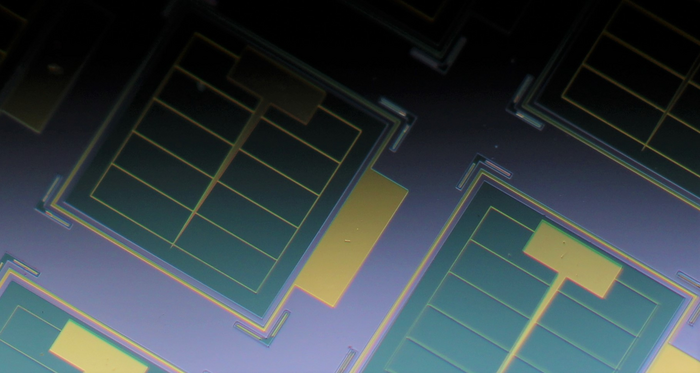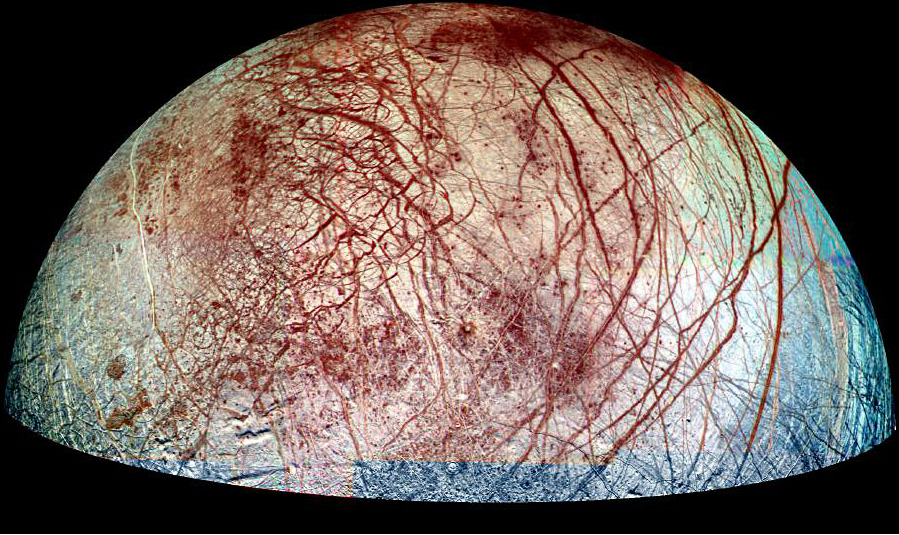Thinner, Lighter Solar Cells Could Help Satellites Survive Deadly Radiation in Space

We could launch satellites into space at a higher altitude than low-Earth orbit, but the radiation there could destroy their electronics and power supply.
A lighter, thinner, radiation-tolerant solar cell could be the solution.
These solar cells could aid space agencies like NASA in exploring alien worlds, such as the Jupiter moon Europa.
Some people like to say outer space is a starry frontier of vast emptiness, but clearly they’ve never tried launching a satellite. Sixty-five years after Sputnik, some 8,000 low-Earth orbit (LEO) satellites now swarm the planet with around 1,400 of them launched in 2021 alone. At this pace, the comfortable orbital belt some 1,200 miles above our heads will become too crowded to play host to future spacecraft. So where do we go from here?
🛰 You love out-of-this world technology. So do we. Let’s nerd out over it together—join Pop Mech Pro.
Satellites can be pushed into higher orbits with the next altitudinal stop being middle or medium-Earth orbits (MEO) stretching out to about 22,300 miles, but at those distances, increased proton radiation from the Van Allen belts wreak havoc on satellite electronics and power supply. This makes the idea of MEO satellites less-than-appetizing—but what if a new kind of radiation-tolerant solar cell could sweeten the deal?
A paper published Tuesday in the Journal of Applied Physics details a new ultrathin solar cell designed to withstand the radiative vigors of deeper orbits. Because these solar cells are so thin, they also eliminate unnecessary bulk that could make satellites lighter, and therefore cheaper, to launch. One day, these radiation-tolerant solar cells could even find themselves on the surface of another world.
Flying High
When scientists were figuring out where to place the world’s first satellites, choosing low-Earth orbit was a no-brainer. Its close proximity to Earth (comparatively) meant less energy required at the launchpad, and satellites phoning home images could do so at much higher resolutions. But one of its biggest advantages was that LEO largely avoided the belts of radiation that surround Earth, formed from Earth’s magnetosphere capturing solar winds. Unfortunately, 60 years of satellite launches have made LEO a pretty crowded place.
“In low-Earth orbit there’s a lot of satellite and junk up there and it’s only going to get worse,” Armin Barthel, the paper’s author and a Ph.D. student at Cambridge University, tells Popular Mechanics. “If we can find alternative solutions to low-Earth orbit, that’s probably a good thing.”
Medium-Earth orbit could be the answer. One example of an MEO orbit is known by the Russian name “Molniya” (meaning “Lightning”), which is a highly elliptical orbit that the Soviet Union first used back in the 1960s. Because Russia is located at higher latitudes, MEO satellites actually perform better than satellites in geosynchronous orbit, which are often trained on Earth’s equatorial region. The World Meteorological Organization also believes these satellites could be crucial for observing Earth’s polar regions.
Unfortunately, satellites on medium-Earth orbits like Molniya have to pass through proton radiation belts and need to be hardened against these high radiation fluxes. “To make them economically viable, these satellites need to last longer and be cheaper,” Barthel says.
Luckily, ultrathin solar cells deliver on both counts.
Powering Up by Sizing Down

Most satellites use photovoltaic solar cells as a power supply. When these cells absorb light, they transfer the energy into negatively charged electrons, are knocked free, and generate electricity across the solar cell. However, when these cells are irradiated, the radiation displaces atoms within these crystallized semiconductors, which causes defects—and these very small defects can be a very big deal.
“The more defects mean the more likely this excited electron is going to meet a defect and lose its energy,” Barthel says. “If you make the cell thinner, you’re reducing the distance the electron needs to travel … it makes it more likely that it’s going to get out the cell and into the cell circuit before it meets a defect.”
And when Barthel says “ultrathin,” he isn’t exaggerating. Modern satellite solar cells can be dozens of microns in size—even solar cells described as “thin” can still measure a micron in width. However, Barthel’s solar cell is about 80 nanometers, which is roughly one-thousandth the size of a human hair (1 micron = 1,000 nanometers).
Barthel and his team created two versions of this ultrathin solar cell: one structured like a typical on-chip design, and the other using a silver back mirror so the solar cell could capture more light. Both use the semiconductor material Gallium Arsenide (GaAs). Because Barthel couldn’t test the chips in a real space environment, the team opted for the next best thing—bathing the solar cells with radiated protons generated at the Dalton Cumbrian Nuclear Facility in England. After studying the damage to the cells using a process called cathodoluminescence and investigating the cell’s energy efficiency with a Compact Solar Simulator, the results proved ultrathin cells outperformed their thicker counterparts by a factor of two.
Although these ultrathin cells could be a boon for a satellite’s survivability beyond low-Earth orbit, a lighter solar cell also means a lighter spacecraft. And because the solar cells are thinner, and therefore less prone to defects, the performance of the cell only improves over time compared to its thicker counterparts. “Because our cells are so thin, they absorb less light because a lot of light passes through,” Barthel says. “Even though we start off with less power … we get to a point [over time] where our cell actually produces more power than the thicker cell.”
These ultrathin, radiation-tolerant solar cells need a bit more time in the oven before they can compete with the solar cells on today’s satellites. Barthel says next steps include improving integrated light management (the silver back mirror which helps the cell capture more light), while also improving the manufacturing process—after all, it’s not easy making something only 80 nanometers thick.
But once it’s ready for the big show, these cells could find their way onboard spacecraft far beyond medium-Earth orbit.
Beyond Earth Orbit

When it comes to exploring other worlds, the Jupiter moon Europa is near the top of the list (seriously, we made a list). The moon’s plumes of water vapor make it a compelling host for extraterrestrial life, its tiger-striped lineae give it a certain “cool” factor, and it all rests upon a thick layer of ice on top of an ocean larger than all of Earth’s oceans combined. NASA is so interested in the moon, in fact, that it’s sending a spacecraft called the Europa Clipper to investigate the icy world.
However, Europa Clipper won’t orbit Europa as its name would suggest. Instead, it’ll orbit the gas giant Jupiter in order to avoid the planet’s own devastating radiation belt. NASA also sent its Juno orbiter into a highly elliptical orbit around Jupiter in 2016 to limit exposure to this damaging radiation. Barthel argues that further investigation into radiation-tolerant solar cells—along with hardening other aspects of future spacecraft — could fundamentally alter how NASA and other space agencies design these missions. “Really high radiation tolerant cells that can survive for a month on the moon would be really cool,” Barthel says.
For now, these cells are a proof of concept that ultrathin designs can make satellites and spacecraft tolerant against harmful radiation found throughout the galaxy. As these solar cells improve, there’s no telling what worlds they’ll help explore.
You Might Also Like
